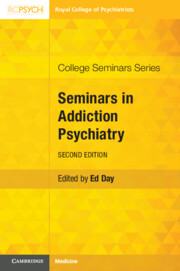Book contents
- Seminars in Addiction Psychiatry
- College Seminars Series
- Seminars in Addiction Psychiatry
- Copyright page
- Contents
- Contributors
- Preface
- Chapter 1 Historical and Conceptual Approaches to Addiction
- Chapter 2 Illicit Drug Use: Epidemiology, Aetiology and Prevention
- Chapter 3 Illicit Drug Use: Clinical Features and Treatment
- Chapter 4 Addiction to Prescription Medication: Benzodiazepines, Z-Drugs and Gabapentinoids
- Chapter 5 Alcohol Use Disorders: Epidemiology and Prevention
- Chapter 6 Alcohol Use Disorders: Aetiology and Pathophysiology
- Chapter 7 Alcohol Use Disorders: Clinical Features and Treatment
- Chapter 8 Psychological Approaches to Addiction
- Chapter 9 Comorbid Substance Use and Mental Illness
- Chapter 10 Medical Aspects of Drug and Alcohol Use
- Chapter 11 Organising Treatment Services for Drug and Alcohol Misusers
- Chapter 12 Tobacco Use Disorders
- Chapter 13 Novel Psychoactive Substances and Club Drugs
- Chapter 14 Addiction Problems in a Family and Social Context
- Chapter 15 Addiction Recovery Mutual-Aid Organisations
- Index
- References
Chapter 12 - Tobacco Use Disorders
Published online by Cambridge University Press: 02 November 2021
- Seminars in Addiction Psychiatry
- College Seminars Series
- Seminars in Addiction Psychiatry
- Copyright page
- Contents
- Contributors
- Preface
- Chapter 1 Historical and Conceptual Approaches to Addiction
- Chapter 2 Illicit Drug Use: Epidemiology, Aetiology and Prevention
- Chapter 3 Illicit Drug Use: Clinical Features and Treatment
- Chapter 4 Addiction to Prescription Medication: Benzodiazepines, Z-Drugs and Gabapentinoids
- Chapter 5 Alcohol Use Disorders: Epidemiology and Prevention
- Chapter 6 Alcohol Use Disorders: Aetiology and Pathophysiology
- Chapter 7 Alcohol Use Disorders: Clinical Features and Treatment
- Chapter 8 Psychological Approaches to Addiction
- Chapter 9 Comorbid Substance Use and Mental Illness
- Chapter 10 Medical Aspects of Drug and Alcohol Use
- Chapter 11 Organising Treatment Services for Drug and Alcohol Misusers
- Chapter 12 Tobacco Use Disorders
- Chapter 13 Novel Psychoactive Substances and Club Drugs
- Chapter 14 Addiction Problems in a Family and Social Context
- Chapter 15 Addiction Recovery Mutual-Aid Organisations
- Index
- References
Summary
Tobacco smoking rates are much higher in people who are in treatment or recovery for a substance use disorder (SUD) and/or mental health condition. Dependence on tobacco is a medical condition, though one that has historically been overlooked in both drug and alcohol and mental health settings. Smoking has a negative impact on substance use and mental health outcomes and contributes to the shorter life span these groups experience. In this chapter the importance of understanding the difference between tobacco and nicotine is discussed, and the prevalence of tobacco smoking and its impact on the health of people with a SUD and/or mental health condition is reviewed. A brief overview of population-level interventions is provided and a detailed section on individual-level interventions to help people quit smoking.
Keywords
- Type
- Chapter
- Information
- Seminars in Addiction Psychiatry , pp. 207 - 229Publisher: Cambridge University PressPrint publication year: 2021



